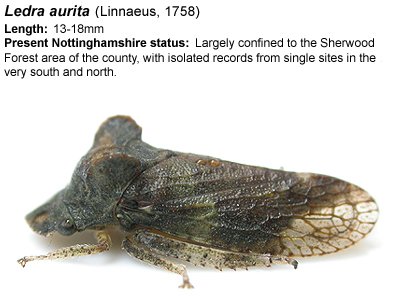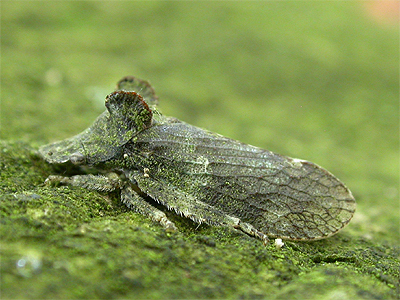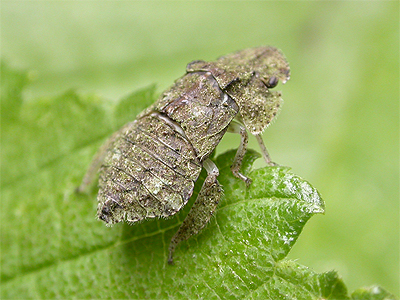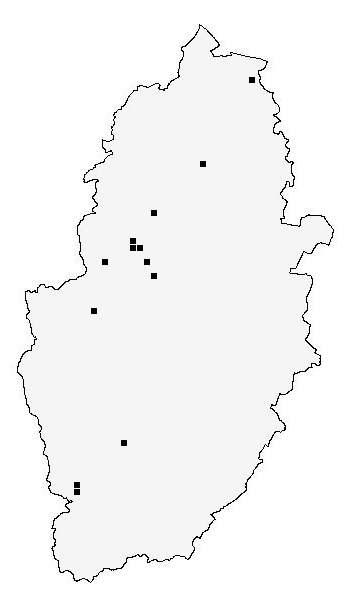

| Looking for the Leafhopper Ledra aurita in Nottinghamshire |
| Occasionally, certain
invertebrates stand out from the rest as being quite
unique within our local fauna. With moths, its often the
larger than life Hawk-moths, among bees and wasps its the
Hornet and with beetles, its probably the combination of
size and colouration of the Musk Beetle. It may be
different if only we had Stag Beetle in Nottinghamshire. With Leafhoppers however, its not really a size or even a colour thing, but just by being something so completely different to anything else, that makes Ledra aurita stand out above all other Leafhoppers. Ledra aurita isn't colourful, but it is very large compared to the other UK species. Most of all, it definitely has that something about it which grabs the attention of the young (and not so young) naturalist. |
 |
|
| .... | ||
| Biology
and status of Ledra aurita in
the UK At some point, there will no doubt come a time when they make a determined effort to track it down. Not such an easy task though, but hopefully this page will point people wishing to see it in the right direction..........no guarantees though. Ledra aurita is found locally in wooded areas across southern counties and is the only member of the Genus Ledra to be found in the UK. Although its superb camouflage may have led to an element of under recording over the years, there seems little doubt (to us at least) that it is indeed a rare insect in Nottinghamshire. Even at relatively well recorded sites such as Sherwood Forest, Ledra went unrecorded for the best part of a century, but there has been an increase in the number of records in the county over recent years. |
| .... | ||
 |
Measuring between 13-18mm
in length, it is considerably larger than any
other UK Leafhopper and is known to have the ability to
stridulate quite loudly. Adults are generally found
between May and September, but can certainly occur until
the first real Autumn or Winter frosts. Fresh adults are
actually grey in colour, although with age, they often
become green through accumulating algae growth off the
trunks and branches of mature trees. Past and present Nottinghamshire status Historically, Ledra aurita always seems to have been a much prized find in Nottinghamshire, and many of the countys most notable naturalists never even encountered it. Described as 'rare' by J.W. Carr in his book "The Invertebrate Fauna of Nottinghamshire" published in 1916, Carr lists just three records - from Treswell Wood (Thornley), Sherwood Forest near Edwinstowe in 1912 and from Thorney in 1913 (L.A. Carr). |
|
| .... | ||
| One found at Attenborough NR on 26/05/07 (Rogers, R.), represented the first Nottinghamshire record for almost a century, remaining somewhat isolated until the first of our Sherwood Forest records in 2010. The full list of county records we know of, are included in the table below. | ||
| .... | ||
|
|||||||||||||||||||||||||||||||||||||||||||||||||||||||||||||||||||||||||||||||||||||||||||||||||||||||||||||||||||||||||||||||||||||||
| All of our records have occurred really quite by chance. Our first caused great excitement, when Ledra's charcteristic shape appeared on the sheet of the MV light we were running at Sherwood Forest CP in August 2010. We thought (and actually wrote at the time) that it would be many years before we ever encountered it again. But while searching the trunks of Beech trees at Holborn Hill Plantation near Meden Vale, we found another near Meden Vale, Ledra aurita on October 2012. | |||||||||||||||||||||||||||||||||||||||||||||||||||||||||||||||||||||||||||||||||||||||||||||||||||||||||||||||||||||||||||||||||||||||
| .... | |||||||||||||||||||||||||||||||||||||||||||||||||||||||||||||||||||||||||||||||||||||||||||||||||||||||||||||||||||||||||||||||||||||||
 |
What we
though at the time was a late date, was to be surpassed
the following year, when while searching the trunks of
trees for newly emerged female Winter Moths to
photograph, we found our third Ledra slowly
crawling down the trunk of an Oak near Hazel Gap on a
very mild November day. Our latest Nottinghamshire distribution map of Ledra aurita, showing the most recent known records is below. The square in the lower left of the county represents Attenborough Nature Reserve and the square in the upper right is Misterton. Sandwiched roughly half-way between, are the Clumber Park and Sherwood Forest records. Looking for Ledra aurita in Nottinghamshire A bit of research always helps when planning a trip to specifically search for any species. Knowledge of where and when to look can cut your search time down enormously, but there will always be an element of luck and a large amount of patience. |
| .... | |||||||
|
 |
||||||
| .... |
| Our October and November records may indicate that once the leaves start to fall, adults descend from the tops of trees, so this may be the best time to finally get the chance to catch up with this unique species. |